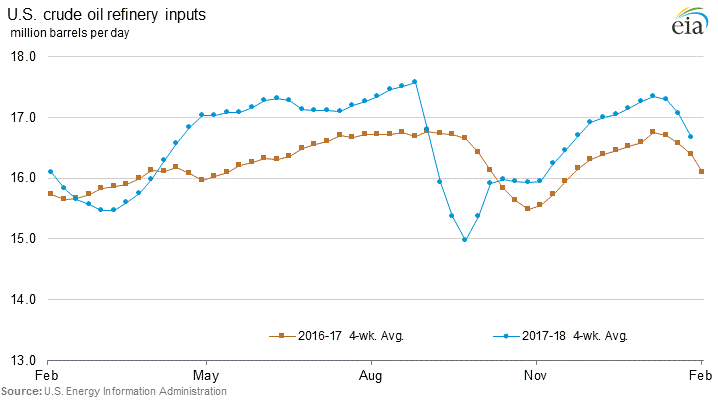U.S. crude oil inventories jumped this past week for the first time in nearly three months, rising by 6.7 million barrels. The inventory increase, coming at a time of surging U.S. oil production, could rattle the oil price rally. However, the stock builds were always expected, and are typical at this time of year.
The jump in inventories put an end to 10 consecutive weeks of inventory drawdowns, which have the stock surplus within sight of the five-year average. That could test the oil price rally, which has sputtered in the last few weeks with Brent at about $70 per barrel and WTI in the mid-$60s.

(Click to enlarge)
But refineries tend to head into maintenance in February and March, retooling ahead of warmer months when demand usually rises. And as most major analysts have predicted (including the IEA, EIA and OPEC), the stock build was expected.
The inventory increase came not coincidentally in a week in which refinery inputs dropped significantly, falling from 17 million barrels per day (mb/d) for the week ending on January 19, to 16.67 mb/d for the week ending on January 26 (4-week averages). As refineries throttle back, the pull on crude oil from inventories declines.
But at least according to the most recent data, the trend isn’t overwhelmingly bearish. Standard Chartered noted that the increase in inventories was not even that large on a seasonal basis, and it was less than the five-year average (although the past five years have included several years of extraordinary stock increases, so the “average” is somewhat misleading). While stocks increased on an absolute basis, they didn’t really increase against that five-year average.
Adding a bit more comfort to oil bulls was the “counter-seasonal draw in gasoline and another sharp draw at Cushing that took inventories below their five-year range,” Standard Chartered wrote in a note. Lower refining runs might mean a diminishing effect on crude demand, but it also means that refineries won’t be stashing so much gasoline into storage. The EIA said that gasoline stocks fell in the most recent week by 1.9 million barrels. Related: Oil Markets Are At A Stalemate
In other words, the stock build is not the bearish news that it might seem, particular because it was widely expected to crop up at some point in the first quarter.
Moreover, the U.S. is only part of the picture. Stocks have been declining around the world, not least because production outside of North America is flat — and in some countries, falling by quite a bit.
“Ultimately, we think the U.S. market is a little bit of a smokescreen actually for the oil industry, with ongoing supply issues elsewhere and also the strong demand, really tightening up this market and further, I suppose, reducing that global inventory glut that OPEC has been targeting for some time,” Daniel Hynes of ANZ told CNBC.
Indeed, Goldman Sachs stated that it believes the rebalancing effort is already here. Instead of just looking at U.S. inventories, OPEC is targeting inventories across the OECD. U.S. oil production is surging, which will push up inventories for a good part of this year, but that isn’t the case elsewhere. Even that data omits what is going on in the non-OECD, where demand is growing at a much faster clip.
Goldman Sachs says the timespreads in the futures market implies that inventories are currently much lower than many people think. OECD stock data is published with a longer lag time, and while it will take time to see a clearer picture, the investment bank estimates that the long-awaited point of rebalancing has arrived. OPEC will keep the cuts in place, and the market will probably tighten well below the five-year average before that is reflected in the data. This is why the bank sees Brent going above $80 per barrel in the next six months.
Nevertheless, the oil market will have a murky picture for a little while longer. The market is tightening, and many expect it to tighten particularly in the second half of this year, but the expected increase in U.S. crude inventories over the next few weeks and months will muddy the waters. Oil traders will see soaring U.S. oil production and inventory builds as a sign that the market tightening has slowed. And indeed, with the preponderance of speculative positions on the bullish side, there is downside risk.
But last week’s inventory increase, and the stock builds to come, don’t necessarily mean that we’re in for another protracted downturn.
By Nick Cunningham of Oilprice.com
More Top Reads From Oilprice.com:
- 2018: The Year Of The Oil Majors
- The Biggest Threat To U.S. Oil Exports
- JP Morgan: Oil Could Hit $78 Within Months

















That is why claims about rising US oil inventories and US shale oil production could hardly have strong bearish impact on oil prices.
Oil prices are heading towards $70/barrel and beyond in 2018 buoyed by fast-rising global oil demand and also rising global economic growth.
Dr Mamdouh G Salameh
International Oil Economist
Visiting Professor of Energy Economics at ESCP Europe Business School, London
That storage is more than 3X the size of US commercial stockpile and has a relatively short time frame for disposal.
The inevitable rush for the exit is beginning . . . . .